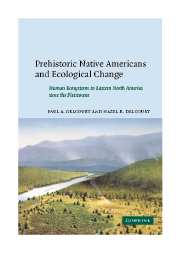 Prehistoric Native Americans and Ecological Change
Prehistoric Native Americans and Ecological Change Book contents
- Frontmatter
- Contents
- Acknowledgements
- PART I PANARCHY AS AN INTEGRATIVE PARADIGM
- PART II ECOLOGICAL FEEDBACKS AND PROCESSES
- 4 Gene-level interactions
- 5 Population-level interactions
- 6 Community-level interactions
- 7 Landscape-level interactions
- 8 Regional-level interactions
- PART III APPLICATION AND SYNTHESIS
- References
- Index
8 - Regional-level interactions
Published online by Cambridge University Press: 30 October 2009
- Frontmatter
- Contents
- Acknowledgements
- PART I PANARCHY AS AN INTEGRATIVE PARADIGM
- PART II ECOLOGICAL FEEDBACKS AND PROCESSES
- 4 Gene-level interactions
- 5 Population-level interactions
- 6 Community-level interactions
- 7 Landscape-level interactions
- 8 Regional-level interactions
- PART III APPLICATION AND SYNTHESIS
- References
- Index
Summary
PALEOINDIANS, MEGAFAUNAL EXTINCTIONS, AND PANARCHY REORGANIZATION
During the late Pleistocene, humans interacted with their environment on a regional scale during a time of major climate change and ecosystem reorganization. Human predation, climate change, plant–animal interactions, and disease each may have played a role in the collapse and reorganization of regional ecosystems at the end of the Pleistocene (Figure 3.4). Regional-level influences of Paleoindians followed from success in immigration, establishment, and increase in human populations to a threshold at which they began to play a discernible role as agents of ecological change in the New World. Adaptations for hunting and foraging (Figure 3.5) would have influenced not only the regional dispersal pattern of human populations across the Americas at the end of the Pleistocene, but also would have determined the extent to which Paleoindians would have been active participants as keystone predators in the extinction of megafauna (adult mammals >44 kg).
DYNAMICS OF LATE-PLEISTOCENE ENVIRONMENTAL CHANGE
During the late Quaternary, mean global temperature warmed by 5 °C from peak glacial cold 18 000 BP to peak interglacial warmth 6000 BP Climate warming was accompanied by changes in hemispheric patterns of atmospheric circulation and shifts in regional storm tracks (Wright, 1989; Lowe et al., 1994). Seasonal temperature contrast at middle and high latitudes heightened after 17 000 BP and peaked between 12 000 and 9000 BP (Figure 8.1) as systematic changes in incoming solar radiation forced the changeover from cool, equable ice-age climate to the highly seasonal late-glacial and early-interglacial pattern of very cold winters offset by very warm summers (Kutzbach and Guetter, 1986).
- Type
- Chapter
- Information
- Prehistoric Native Americans and Ecological ChangeHuman Ecosystems in Eastern North America since the Pleistocene, pp. 134 - 160Publisher: Cambridge University PressPrint publication year: 2004


